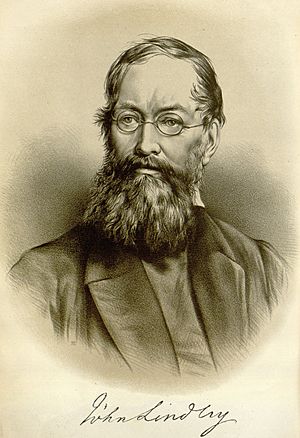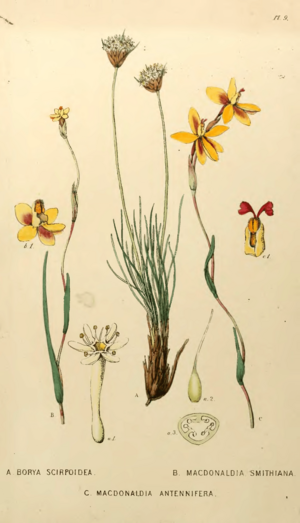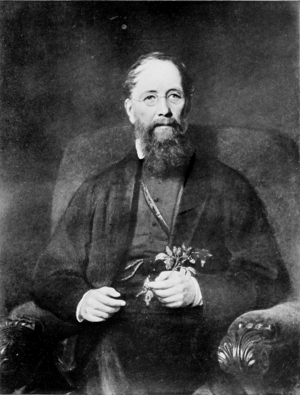John Lindley facts for kids
Quick facts for kids
John Lindley
|
|
|---|---|

John Lindley
|
|
| Born | 5 February 1799 Catton, England
|
| Died | 1 November 1865 (aged 66) |
| Nationality | English |
| Alma mater | Norwich School |
| Awards | Royal Medal (1857) |
| Scientific career | |
| Fields |
|
| Institutions | Royal Horticultural Society |
| Author abbrev. (botany) | Lindl. |
John Lindley (born February 5, 1799 – died November 1, 1865) was an English expert in plants, a gardener, and a specialist in orchids. He was also a Fellow of the Royal Society (FRS), which is a big honor for scientists.
Contents
Early Life and First Steps in Botany
John Lindley was born in Catton, a small place near Norwich, England. He was one of four children. His father, George Lindley, owned a plant nursery and was good with fruit trees. Even though his father knew a lot about plants, the business didn't make much money.
From a young age, John helped in the garden. He also loved collecting wild flowers from the Norfolk countryside. He went to Norwich School. John wanted to go to university or join the army, but his family couldn't afford it. In 1815, he started working as an agent for a seed company in London.
Around this time, John met William Jackson Hooker, another plant expert. Hooker let John use his amazing plant library. He also introduced John to Sir Joseph Banks, a very important scientist who hired John as an assistant.
In 1819, John published his first work. It was a translation of a book about fruits. The next year, in 1820, he published his own book called Monographia Rosarum. This book described new types of roses and included his own drawings. He also wrote about foxgloves (Digitalium) and apple-like plants (Pomaceae).
A Career in Plants and Gardens
Lindley started working at Sir Joseph Banks's home in London. He focused on studying roses and foxgloves. He wrote a book called "A Botanical History of Roses." In this book, he described 76 types of roses and found 13 new ones. He even painted 19 colorful pictures for the book himself.
He became friends with Joseph Sabine, who was the Secretary of the Horticultural Society of London. Sadly, Banks died a few months later, and John's job ended. But a rich merchant named William Cattley, a friend of Banks, paid John to draw and describe new plants in his garden. He also paid for John's book on foxgloves. Later, Lindley named a beautiful type of orchid, Cattleya, after William Cattley.
In 1820, when he was just 21, John Lindley became a member of the Linnean Society of London. This was a big achievement for a young scientist.
Collecting and Studying Rare Plants
From 1821 to 1826, Lindley published a large book with colorful pictures he had painted. It was called "Collectanea botanica or Figures and botanic Illustrations of rare and curious exotic Plants." Many of these plants were orchids, which he loved studying throughout his life.
In 1822, Lindley became the assistant secretary for the Royal Horticultural Society. He helped manage their new garden in Chiswick and oversaw the collection of many plants.
Teaching and Exploring New Plants
In 1829, Lindley became a professor of botany at University College, London. He kept this job until 1860. He also gave lectures on plants at the Royal Institution starting in 1831. In 1833, he even gave the famous Christmas Lecture there. From 1836, he taught at the Chelsea Physic Garden.
Lindley described plants that were collected during Thomas Livingstone Mitchell's trips in 1838. He also wrote about plants from the Swan River Colony in Western Australia. These plants were collected by James Drummond and Georgiana Molloy. Lindley's 1840 book, 'Sketch of the Vegetation of the Swan River Colony,' gave a clear picture of the plants in that area. This book had nine hand-colored pictures and four wood-cuts. He also helped Charles Moore become the Director of the Sydney Botanical Gardens.
During his time as a professor, Lindley wrote many scientific and popular books. He also helped edit the Botanical Register for many years. He co-founded The Gardeners' Chronicle with Joseph Paxton and others, and he managed its gardening section from 1841. He was a member of the Royal, Linnean, and Geological Societies. In 1857, he received the Royal Society's Royal Medal.
Leading the Horticultural Society
The Horticultural Society of London, which later became the Royal Horticultural Society, asked Lindley to draw roses. In 1822, he became the Assistant Secretary of the Society's garden. A historian of the Society later called him "the backbone of the Society and possibly the greatest servant it had ever had."
With a steady income, John married Sarah Freestone in 1823. They rented a house in Acton Green, which was close to the Society's garden.
The Society's Secretary, Joseph Sabine, spent too much money on big projects. Lindley tried to stop him, but he couldn't. By 1830, the Society had a lot of debt. Sabine resigned, and Lindley successfully helped the Society recover with the new Honorary Secretary, George Bentham.
Important Work and Discoveries
A famous plant expert, John Claudius Loudon, asked Lindley to help him with his "Encyclopedia of Plants." This huge book covered almost 15,000 types of flowering plants and ferns. Lindley did most of the work for this project.
While working on the encyclopedia, which finished in 1829, Lindley became convinced that the "natural" way of classifying plants was better. This system was created by Antoine Laurent de Jussieu. Lindley believed it showed how nature truly organized plants, unlike the "artificial" system by Linnaeus. He wrote about this in his books, A Synopsis of British Flora, arranged according to the Natural Order (1829) and An Introduction to the Natural System of Botany (1830).
In 1828, Lindley became a member of the Royal Society of London. In 1833, he received an honorary Doctor of Philosophy degree from the University of Munich. He also received honors from France, the United States, and Switzerland.
In 1829, Lindley became a professor of botany at the new London University to earn more money. He continued his job at the Royal Horticultural Society. Even though he hadn't gone to university himself, he was an excellent teacher. He gave six hour-long lectures every week. He even wrote his own plant textbooks for his students because he wasn't happy with the ones available.
Saving Kew Gardens
After the death of King George III, the Royal Botanic Gardens at Kew started to decline. The government asked Lindley, Joseph Paxton, and John Wilson to write a report about the gardens' future. They recommended keeping the gardens, but the government wanted to close them down and get rid of the plants.
On February 11, 1840, Lindley told the Prime Minister that the issue would be discussed in Parliament. This caused a public outcry. People were very upset, so the government changed its mind, and the gardens were saved! William Hooker was then appointed as the new Director.
Investigating the Potato Blight
In 1845, Lindley was part of a scientific group set up by the government to study potato blight. This was a plant disease that caused the Irish famine. At the time, people didn't know that a fungus caused the disease; they thought bad weather was to blame.
Even though the group couldn't solve the problem, their report led to the end of the 1815 Corn Laws. These laws had stopped cheap wheat from America from being imported. This helped people who relied on growing only potatoes for food. In 1859, he was elected an honorary member of the American Academy of Arts and Sciences.
Lindley worked very hard and published many books. One important book was The Genera and Species of Orchidaceous Plants, which took him ten years to write. He was known as the best expert on classifying orchids of his time. Other botanists, like Bentham and Hooker, recognized many of the orchid types he had named and described.
Other plant experts respected him greatly. More than 200 plant species were named after him, using names like "lindleyi" or "lindleyana."
Later Years and Legacy
In 1861, Lindley was in charge of organizing the exhibits from British colonies for the International Exhibition in South Kensington. This was very tiring work and seemed to affect his health. His memory also started to get worse. He resigned from his university job that year and from his position at the Royal Horticultural Society two years later.
In 1863, he traveled to Vichy, a spa in France, but his health continued to decline. He died at his home in Acton Green, near London, at the age of 66. He was survived by his wife, two daughters (including Sarah Lindley Crease), and a son. His daughters were talented artists, and his son, Nathaniel, became a famous lawyer.
See also
Template:Kids robot.svg In Spanish: John Lindley para niños
- Lindley system
- Hundred of Lindley



